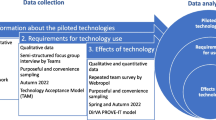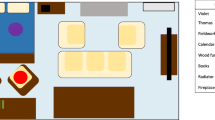Abstract
Optimistic expectations of technology can be identified in policy documents, academic centres and businesses that aim to create and promote a variety of technologies so that older people can age at home. This article draws on recent data from Ireland and Finland, two countries at different stages of technological development, to examine the role of technology in the home care for older adults. Research participants (service providers and care recipients) agreed that technology could play an important role by improving communications, enabling social contact, and connecting the ‘lone worker’ and ‘isolated patient’ to other stakeholders in home care services. However, participants also had serious concerns around technology. Care was conceptualised as relational and participants expressed apprehension about technology replacing face-to-face contact. Service providers expressed trepidation about the digital divide and technology driving further inequalities in the future. It is important that attempts to develop technology for older adults consider the concerns identified in this study, in order for home care technology to be successfully implemented, widely adopted and meaningfully used.
Similar content being viewed by others
Notes
Telecare is an umbrella term referring to the technical devices and professional practices applied in ‘care at a distance’, care that supports chronically ill or older people living at home (Currell et al., 2000).
Telepresence has been defined as ‘the subjective experience of being together with a person in one place when one is geographically situated in another’ (Sävenstedt, et al., 2004).
References
Aceros, J. C., Pols, J., & Domenech, M. (2015). Where is grandma? Home telecare, good aging and the domestication of later life. Technological Forecasting and Social Change, 93, 102–111.
Andreassen, H. K., & Dyb, K. (2010). Differences and Inequalities in Health. Information, Communication & Society, 13, 956–975.
Baker, J., Lynch, K., Cantillon, S., & Walsh, J. (2004). Equality; from theory to action. Palgrave MacMillan.
Bolton, S., & Wibberley, G. (2014). Domiciliary care: The formal and informal labour process. Sociology, 48(4), 682–697.
Breckenridge, J., & Jones, D. (2009). Demystifying theoretical sampling in grounded theory research. Grounded Theory Review, 8(2), 113–126.
Care Alliance Ireland. (2015). Family Caring in Ireland. CAI. Available at: https://www.carealliance.ie/userfiles/file/Family%20Caring%20in%20Ireland%20Pdf.pdf. Accessed 17 Aug.
Carretero S., Stewart J., Centeno C., Barbabella F., Schmidt A., Lamontagne-Godwin F., & Lamura, G. (2012) Can technology-based services support long-term care challenges in home care? Analysis of evidence from social innovation good practices across the EU: CARICT project summary report – Study. Publications Office of the European Union. Available at: https://publications.europa.eu/en/publication-detail/-/publication/0cafdee8-756e-4952-b432-347b2a80002e. Accessed 4th Mar 2019.
Conlon, C., Timonen, V., Elliott-O’Dare, C., O’Keeffe, S., & Foley, G. (2020). Confused about theoretical sampling? engaging theoretical sampling in diverse grounded theory studies. Qualitative Health Research, 30(6), 947–959. https://doi.org/10.1177/1049732319899139.
CSO. (2016). Census of Population 2016 – Profile 8 Irish Travellers, Ethnicity and Religion. Dublin, Central Statistics Office. Available: https://www.cso.ie/en/releasesandpublications/ep/p-cp8iter/p8iter/p8itd. Accessed 1 May 2019.
CSO. (2017). Information Society Statistics - Households [Online]. Central Statistics Office. Available: https://www.cso.ie/en/releasesandpublications/er/isshh/informationsocietystatistics-households2017/. Accessed 10th June 2018.
Currell, R., Urquhart, C., Wainwright, P., et al. (2000). Telemedicine versus face to face patient care: effects on professional practice and health care outcomes. John Wiley & Sons, The Cochrane Library.
Currie, W. L., & Seddon, J. J. M. (2014). A cross-national analysis of eHealth in the European Union: Some policy and research directions. Information & Management, 51(6), 783–797.
Dentzer, S. (2013). Rx for the `blockbuster drug’ of patient engagement. Health Affairs, 32(2), 202.
Deusdad, B. A., Pace, C., & Anttonen, A. (2016). Facing the challenges in the development of long-term care for older people in Europe in the context of an economic crisis. Journal of Social Service Research, 42(2), 144–150.
Donnelly, S., O’Brien, M., Begley, E., & Brennan, J. (2016). “I’d prefer to stay at home but I don’t have a choice” meeting older people’s preference for care: Policy, but what about practice? University College Dublin.
Draper, H., & Sorell, T. (2017). Ethical values and social care robots for older people: An international qualitative study. Ethics Information Technology, 68, 19–49.
EVA. (2016). Robotit töihin. Robotit tulivat - mitä tapahtuu työpaikoilla? [Robots to work. Robots came - what is happening in working places?]. Accessible at https://www.eva.fi/wp-content/uploads/2016/09/Robotit-t%C3%B6ihin.pdf. Accessed 12.6.2018.
Finlex. (2012). Act on supporting the functional capacity of the older population and on social and health care services for older persons. Accessible at: http://www.finlex.fi/fi/laki/kaannokset/2012/en20120980.pdf. Accessed: 14 June 2018.
Fex, A., Ek, A. C., & Söderhamn, O. (2009). Self-care among persons using advanced medical technology at home. Journal of Clinical Nursing, 18, 2809–2817.
Genet, N., Kroneman, M., & Boerma, W. G. (2013). Explaining governmental involvement in home care across Europe: An international comparative study. Health Policy, 110(1), 84–93.
Harvey, B., & Walsh, K. (2016). Loneliness and Ageing: Ireland, North and South. Institute of Public Health in Ireland.
Joyce, K., & Loe, M. (2010). A sociological approach to ageing, technology and health. Sociology of Health and Illness, 32, 171–180.
Kreps, G. L. (2005). Disseminating relevant health information to underserved audiences: Implications of the Digital Divide Pilot Projects. Journal Medical Library Association, 93, S68–S73.
Krick, T., Huter, K., Domhoff, D., Schmidt, A., Rothgang, H., & Wolf-Ostermann, K. (2019). Digital technology and nursing care: A scoping review on acceptance, effectiveness and efficiency studies of informal and formal care technologies. BMC Health Services Research, 19(1), 400. https://doi.org/10.1186/s12913-019-4238-3.
Lolich, L., Riccò, I., Deusdad, B. & Timonen, V. (2019). Embracing technology? Health and Social Care professionals' attitudes to the deployment of e-Health initiatives in elder care services in Catalonia and Ireland. Technological forecasting & social change, 147, 63–71.
Lupton, D. (2014). Critical perspectives on digital health technologies. Sociology Compass, 8(12), 1344–1359.
Lupton, D. (2016). Towards critical digital health studies: Reflections on two decades of research in health and the way forward. Health, 20, 49–61.
Lynch, K. (2009). Affective equality: Love, care and injustice. Palgrave Macmillan.
Martin S. (2010). Research into the Future Housing and Support Needs of Older People. Electronic assistive technology – supporting older people within local communities. Northern Ireland Housing Executive.
McGowan, J. J. (2008). The pervasiveness of telemedicine: Adoption with or without a research base. Journal of General Internal Medicine, 23, 505–507.
Mcdonald, A., Lolich, L., Timonen, V. & Warters, A. (2019). Time is more important than anything else: tensions of time in the home care of older adults in Ireland. International journal of care and caring, 3, 501–515.
Ministry of Social Affairs and Health. (2018). #HYTEAIRO 2018 - Kansallinen hyvinvoinnin AiRo -ohjelma. Accessible at http://airoisland.fi/hyteairo/raportti/. Accessed 12.6.2018.
Mort, M., Roberts, C., & Callen, B. (2013). Ageing with telecare: Care or coercion in austerity? Ageing with telecare. Sociology of Health & Illness, 35, 799–812.
OECD. (1994). New orientations for social policy social policy studies 12. Organisation for Economic Co-operation and Development.
Pirhonen, A., Tuuri, K., & Erkut, C. (2017). Human–Technology choreographies. Human Technology, 13(1), 6–9. https://doi.org/10.17011/ht/urn.201705272515.
Rose. (2017). Robotics in Care Services: A Finnish Roadmap. Available: http://roseproject.aalto.fi/images/publications/Roadmap-final02062017.pdf. Accessed 18 June 2018.
Sävenstedt, S., Zingmark, K., & Sandman, P. O. (2004). Being present in a distant room: Aspects of teleconsultations with older people in a nursing home. Qualitative Health Research, 14, 1046–1057.
Scammell, J., Tait, D., White, S., & Tait, M. (2017). Challenging nurse student selection policy: Using a lifeworld approach to explore the link between care experience and student values. Nursing Open, 4, 218–229.
Shaw, B., Gustafson, D. H., Hawkins, R., McTavish, F., McDowell, H., Pingree, S., & Ballard, D. (2006). How underserved breast cancer patients use and benefit from eHealth programs: Implications for closing the digital divide. American Behavioral Scientist, 49, 823–834.
Shore, L. de Eyto A. and O’Sullivan, L. (2020). Technology acceptance and perceptions of robotic assistive devices by older adults – implications for exoskeleton design, Disability and Rehabilitation: Assistive Technology.
Sixsmith, A., & Sixsmith, J. (2008). Ageing in Place in the United Kingdom. Ageing International, 32, 219–235.
Sparrow, R., & Sparrow, L. (2006). In the hands of machines? The future of aged care. Minds and Machines, 16, 141–161.
Spasova S., Baeten R., Coster S., Ghailani D., Peña-Casas R., & Vanhercke B. (2018). Challenges in long-term care in Europe. A study of national policies. European Social Policy Network. European Commission.
Statistics Finland. (2017). Mobile phone is becoming increasingly popular for using the Internet - use purposes are diversifying. Accessible at https://www.stat.fi/til/sutivi/2017/13/sutivi_2017_13_2017-11-22_tie_001_en.html. Accessed 12.6.2018.
Taipale, S., & Hänninen, R. (2018) More years, more technologies: aging in the digital era. Human Technology, 14(3).
Timonen, V. (2016). Beyond successful and active ageing: A theory of model ageing (p. 119). Policy Press.
Timonen, V., Foley, G., & Conlon, C. (2018). Challenges when using grounded theory: A pragmatic introduction to doing GT research. International Journal of Qualitative Methods, 17(1). https://doi.org/10.1177/1609406918758086.
Turkle, S. (2011). Alone together: Why we expect more from technology and less from each other. Basic Books.
Vaittinen, T. (2015). The power of the vulnerable body. International Feminist Journal of Politics, 17, 100–118.
Weiss, D., Rydland, H. T., Øversveen, E., Jensen, M. R., Solhaug, S., & Krokstad, S. (2018). Innovative technologies and social inequalities in health: A scoping review of the literature. PLoS ONE, 13(4), 1–20.
Wisdom, J., & Creswell, J. W. (2013) Mixed methods: Integrating quantitative and qualitative data collection and analysis while studying patient-centered medical home models. Agency for Healthcare Research and Quality. February 2013. AHRQ Publication No. 13-0028-EF.
Acknowledgements

Funding
Parts of this article relate to the H2020 SoCaTel Project. This project has received funding from the European Union’s Horizon 2020 research and innovation programme under grant Agreement No 769975.
The relevant contents of this publication are the sole responsibility of the authors Lolich & Timonen and can in no way be taken to reflect the views of the European Commission. We would like to express our gratitude to all focus groups and participants and to our colleagues in the SoCaTel project.
Part of this study was supported by the Academy of Finland, the Strategic Research Council (project ROSE, decision numbers: 292980 and 314180.
Author information
Authors and Affiliations
Corresponding author
Ethics declarations
Conflict of interest
The authors declare that they have no conflict of interest.
Additional information
Publisher's Note
Springer Nature remains neutral with regard to jurisdictional claims in published maps and institutional affiliations.
Rights and permissions
About this article
Cite this article
Lolich, L., Pirhonen, J., Turja, T. et al. Technology in the Home Care of Older People: Views from Finland and Ireland. J Cross Cult Gerontol 37, 181–200 (2022). https://doi.org/10.1007/s10823-022-09449-z
Accepted:
Published:
Issue Date:
DOI: https://doi.org/10.1007/s10823-022-09449-z




